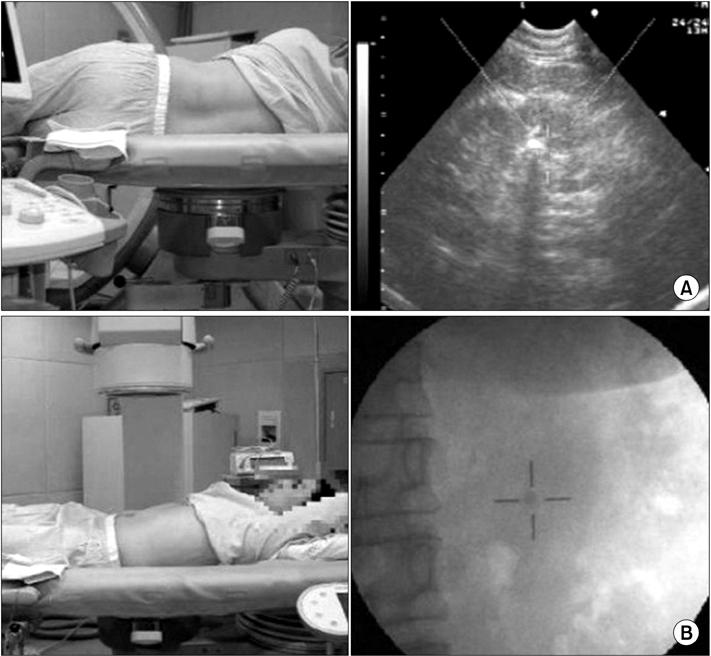Korean J Urol.
2013 Aug;54(8):531-535. 10.4111/kju.2013.54.8.531.
Relationship Between Patient Position and Pain Severity During Shock Wave Lithotripsy for Renal Stones With the MODULITH SLX-F2 Lithotripter: A Matched Case-Control Study
- Affiliations
-
- 1Department of Urology, Samsung Medical Center, Sungkyunkwan University School of Medicine, Seoul, Korea. deokhyun.han@samsung.com
- KMID: 1840466
- DOI: http://doi.org/10.4111/kju.2013.54.8.531
Abstract
- PURPOSE
We evaluated the association between shock wave lithotripsy (SWL)-related pain and patient positioning during SWL.
MATERIALS AND METHODS
We retrospectively reviewed the medical records of 162 patients who underwent their first SWL session for single renal stones from May 2010 to August 2011. One hundred thirteen patients underwent SWL in the supine position and 49 did so in the lateral position. To evaluate an unbiased estimation of the positional effect on pain severity during SWL, both groups (supine vs. lateral) were matched according to sex, age, body mass index, stone location, and stone size. Thirty-four patients from each group were selected for analysis. Pain was evaluated with an average visual analogue scale (VAS-avg) and maximum visual analogue scale (VAS-max). Analgesic usage was also compared between the groups.
RESULTS
All patients (n=34) in the supine group had radio-opaque stones compared with only 47.1% of the patients in the lateral group (n=16). The VAS-avg and VAS-max of the lateral group were significantly lower than those of the supine group (1.2+/-1.0 and 3.1+/-1.7 for VAS-avg and 2.5+/-1.8 and 4.7+/-1.9 for VAS-max, respectively, p<0.05). However, analgesic usage between groups did not differ significantly (17.6% in the supine group vs. 5.9% in the lateral group, p=0.259). In a subgroup analysis confined to patients with radio-opaque stones, the supine group still suffered more pain.
CONCLUSIONS
Patients with renal stones suffered more SWL-related pain in the supine position than in the lateral position. During SWL, positioning of patients should be considered a predictive factor for SWL-related pain.
MeSH Terms
Figure
Reference
-
1. Schmiedt E, Chaussy C. Extracorporeal shock-wave lithotripsy (ESWL) of kidney and ureteric stones. Int Urol Nephrol. 1984. 16:273–283.2. Ozcan S, Yilmaz E, Buyukkocak U, Basar H, Apan A. Comparison of three analgesics for extracorporeal shock wave lithotripsy. Scand J Urol Nephrol. 2002. 36:281–285.3. Gupta NP, Kumar A. Analgesia for pain control during extracorporeal shock wave lithotripsy: current status. Indian J Urol. 2008. 24:155–158.4. Bierkens AF, Maes RM, Hendrikx JM, Erdos AF, de Vries JD, Debruyne FM. The use of local anesthesia in second generation extracorporeal shock wave lithotripsy: eutectic mixture of local anesthetics. J Urol. 1991. 146:287–289.5. Tritrakarn T, Lertakyamanee J, Koompong P, Soontrapa S, Somprakit P, Tantiwong A, et al. Both EMLA and placebo cream reduced pain during extracorporeal piezoelectric shock wave lithotripsy with the Piezolith 2300. Anesthesiology. 2000. 92:1049–1054.6. Oh SJ, Ku JH, Lim DJ, Byun SS, Kim HH. Subjective pain scale and the need for analgesia during shock wave lithotripsy. Urol Int. 2005. 74:54–57.7. Tokgoz H, Hanci V, Turksoy O, Erol B, Akduman B, Mungan NA. Pain perception during shock wave lithotripsy: does it correlate with patient and stone characteristics? J Chin Med Assoc. 2010. 73:477–482.8. Berwin JT, El-Husseiny T, Papatsoris AG, Hajdinjak T, Masood J, Buchholz N. Pain in extracorporeal shock wave lithotripsy. Urol Res. 2009. 37:51–53.9. Pareek G, Hedican SP, Lee FT Jr, Nakada SY. Shock wave lithotripsy success determined by skin-to-stone distance on computed tomography. Urology. 2005. 66:941–944.10. Chapman CR, Casey KL, Dubner R, Foley KM, Gracely RH, Reading AE. Pain measurement: an overview. Pain. 1985. 22:1–31.11. Kim H, Neubert JK, Rowan JS, Brahim JS, Iadarola MJ, Dionne RA. Comparison of experimental and acute clinical pain responses in humans as pain phenotypes. J Pain. 2004. 5:377–384.12. Fillingim RB. Individual differences in pain responses. Curr Rheumatol Rep. 2005. 7:342–347.13. Vergnolles M, Wallerand H, Gadrat F, Maurice-Tison S, Deti E, Ballanger P, et al. Predictive risk factors for pain during extracorporeal shockwave lithotripsy. J Endourol. 2009. 23:2021–2027.
- Full Text Links
- Actions
-
Cited
- CITED
-
- Close
- Share
- Similar articles
-
- Extracorporeal Shock Wave Lithotripsy: Experience of the Year with Modulith SLX
- Comparison of ESWL Monotherapy with EDAP LT-01 and Storz Modulith SLX for Staghorn Calculi
- Comparative Results of Extracorporeal Shock Wave Lithotripters with Three Kinds of Shock Wave Generator
- Are Newer Extracorporeal Shock Wave Lithotripsy Models Truly Improving Pancreatolithiasis Lithotripsy Performance? A Japanese Single-Center Study Using Endoscopic Adjunctive Treatment
- Comparison OF Northgate SD-3 and Modulith SLX Lithotriptors: Treatment Results with 2,000 Renal and Ureteral Stones


